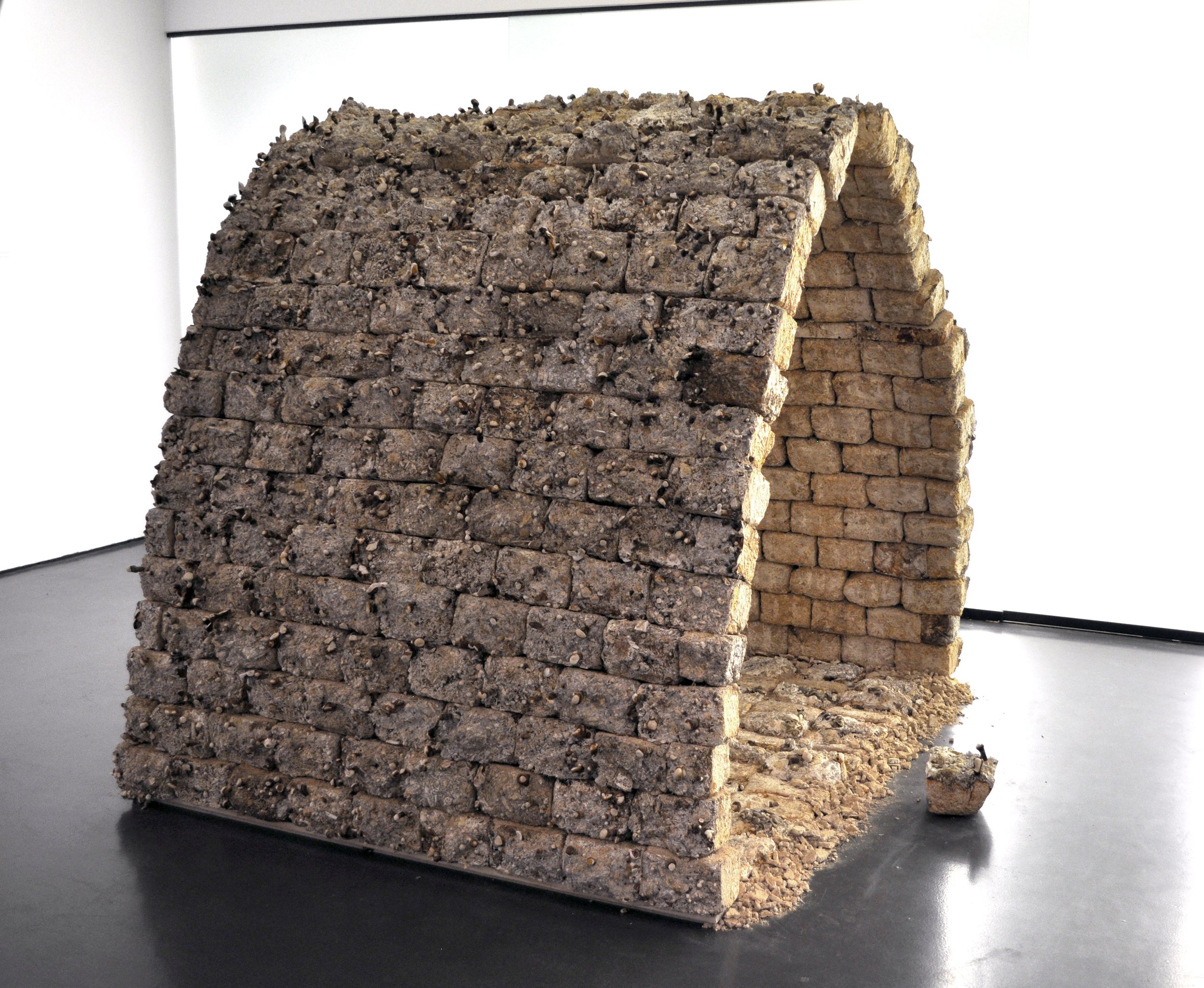Reishi Fine Mycelium™ by MycoWorks. Photo credit: MYCOWORKS
It looks like a piece of fine leather. You pick it up and run your fingers over its glossy and pebbled surface. You bend it back and forth. You gently rub it between your thumb and forefinger. Then you lift it to your nose and inhale. It smells clean, faintly sweet—a scent that’s hard to place.
You can’t pin it down because this is a new material. It’s Reishi™, a leather alternative made from the mycelium, or root fibers, of Ganoderma lucidum, also known as the reishi mushroom.
It’s also the first commercial product of MycoWorks, a California-based biomaterials company founded not by scientists or engineers but by two artists, Phil Ross and Sophia Wang. Since 2013, when they incorporated MycoWorks, this improbable duo of sculptor and dancer/poet have grown the tiniest spore of an idea into a company that’s now at the forefront of a potentially billion-dollar industry.
The mycelium artist
Fungi are the hidden shapers of the forest ecosystem. They live symbiotically with trees and plants, unlocking nutrients for them in life and consuming them in death. What we eat—mushrooms—are the fruiting bodies of the fungus. But most of the organism, its mycelia, grows beneath the surface as filaments and mats.
For nearly thirty years, the mycelium of Ganoderma lucidum was Phil Ross’s muse—or perhaps more accurately, his obsession. He filled his San Francisco apartment with tubs to grow it in, filters to clean its air, and fans and heaters to dry it out. In his hybrid laboratory and artist’s studio, Ross worked to unlock Ganoderma’s secrets. And he prayed his landlord wouldn’t stop by for a look.
Phil Ross in his studio with pieces of cast mycelium. Photo credit: JJ CASAS/845A
Ross learned how to coax his mushroom into geometric shapes and delicate arches—much as other artists mold plaster or clay. But unlike those materials, his artistic medium was alive.
Over decades of patient experimentation, the mushroom taught him what it could do—how it responded to light, heat, and different atmospheres; what foods it preferred, and how it moved around or through man-made barriers. Like a bonsai master who trains the branches of a miniature tree to arc and bend, Ross grew his mycelium into ever more fantastical shapes. But he was also inventing a tradition; there had never been a mycelium sculptor before him.
"Mycotectural Alpha" by Phil Ross, exhibited at Kunsthalle Düsseldorf as part of the Eat Art exhibit in 2009. Photo credit: PHIL ROSS
In 2009, an exhibit at the Kunsthalle Düsseldorf included a Ross teahouse called “Mycotectural Alpha” made of mycelium blocks that was slowly taken apart and brewed into a mushroom tea during the course of the show. Other museum exhibitions featuring Ross’s sculpture followed, including those at New York’s Museum of Modern Art, the Los Angles Country Museum of Art, Carnegie Mellon University, and the Moscow Biennale of Contemporary Art.
In 2012 Ross joined the Workshop Residence in San Francisco, a now-defunct cooperative that paired artists with local manufacturers and created a dramatic series of chairs and stools made from mycelium and reclaimed hardwoods.
That’s when the construction industry took notice and began calling Ross to inquire if mycelium might be an appropriate material for a wide range of building products. His two-decade experience sculpting and working with fungus convinced him it most certainly was. So Ross and Sophia Wang, a dancer and poet he had partnered with several years earlier to produce an exhibition called “BioTechnique” at the Yerba Buena Center for the Arts, founded MycoWorks to explore the commercial prospects of mycelium.
Like Ross, Wang had grown up in New York City. A child of research scientists, she remembers family conversations about biological systems but also regular visits to the Metropolitan Museum of Art, the opera and ballet. After studying visual arts and English literature at Columbia, Wang headed west to start a dance company and pursue a Ph.D. in contemporary American epic poetry at UC Berkeley.
Sophia Wang performing with the Brontez Purnell Dance Company in "Episodes" 2014. Photo credit: ROBBIE SWEENY
“My mother really steeped us in a cultural education,” Wang said in an interview. “She couldn’t be too mad or surprised when I wanted to become an artist. But I think both my parents were still hoping I’d become a scientist.”
An orientation toward fashion
In those first years in business, Ross, Wang, and a handful of MycoWorks employees mainly pursued construction applications for mycelium. They talked with potential clients like Home Depot and Lowe’s about using mycelium as insulation between walls, a sheetrock substitute, or as cladding under a veneer.
The possibilities were promising, but it didn’t take. The economies of scale and volumes needed to succeed in manufacturing were a barrier for their small start-up. So was a bias against new materials in a risk-averse industry. “I think there’s another reason we didn’t find traction in that direction,” remembered Wang. “When you hide the mycelium you lose the unique grain, colors and textures of the material itself.”
Then, in late 2015, they connected with a shoe company that was curious about some of the more pliable forms of mycelium which Ross’s artwork had explored over the years. That interest inspired MycoWorks to begin testing a completely different market.
“It immediately felt like the right direction for us because in the fashion industry, aesthetics and innovative design can shine,” said Wang. “A new material that comes from the earth but which no one has used before? That’s a rich story—and fashion loves a story like that.”
Hermès Victoria in Sylvania. Photo credit: COPPI BARBIERI
Hermès was the first luxury brand attracted to the MycoWorks story and its unique Fine Mycelium™ technology. For more than three years the two companies worked together to create a new material for Hermès designers. In 2021 they announced Sylvania, a proprietary mycelium leather that will soon go into production in one of Hermès’ most popular travel bags, the Victoria Voyage.
“I think the fashion brands appreciate that we are founded by artists, as opposed to this coming out of a lab,” said Wang. “We value the aesthetic rigor of making something beautiful, making something that performs well, making something that is an object of desire.”
Nick Fouquet, a bespoke hat-maker in Venice Beach, California, was one of the first artisans attracted to the promise of this new material. For Fouquet, crafting a hat made from Reishi™ felt familiar, like working with leather and fabric, but with qualities all its own. The success of his Boletus, a hat made entirely of Reishi™, proved to MycoWorks that craftspeople who value the material for its creative potential, not just sustainability, were going to push the boundaries of what was possible.
And the pace of that interest is quickening. In the past few months, the luxury leather atelier, Cuir du Vaudreuil, and high-end furniture company, Ligne Roset, have established partnerships with MycoWorks, marrying their many-generations expertise in traditional leather-crafting with MycoWorks’ more focused knowledge.
“Because our product behaves slightly differently than calf or cow or lamb it’s a challenge,” said Phil Ross in an interview. “But artisans are like, I can work with this. They don’t have to work with a substandard material. It’s more like, I can adapt my skills to this. That’s the magic. That’s what carries culture forward.”
At the helm of MycoWorks, CEO Matt Scullin now leads a diverse and growing team of materials scientists, aerospace engineers and experts in indoor agriculture. With a $125 million round of Series C funding in hand, the company will soon launch its first full-scale production facility. An office for European operations opened in Paris in October of 2022. And a new investment from the General Motors corporation is targeting the development of automobile-focused applications for Fine Mycelium™.
Art comes full circle at MycoWorks
So where do its artist-founders, Phil Ross and Sophia Wang, fit in?
Wang is now Chief of Culture at MycoWorks, a role she’s thrilled to develop. “At the beginning in a start-up, you’re doing everything from maintenance crew to CEO. And I definitely put in time at every single job in the company,” said Wang. “Chief of Culture is about scaling our founding values and making sure that as we grow, the culture of the company and how we work together reflects these values.”
Sophia Wang, MycoWorks Chief of Culture, in New York City's Times Square being honored by Fashion Impact Fund's 2022 Conscious Fashion Campaign. Photo credit: SPREADHOUSE
Recognizing how and where new ideas are born is one of those values, according to Wang. “Being artists who founded a company that went in the direction of material science, development and manufacturing, we have as a founding ethos that creativity happens in every corner, if you let it.”
For co-founder Phil Ross, Ganoderma lucidum, his muse, still has secrets to reveal—and he wants to know them. As Chief Technology Officer at MycoWorks, Ross exudes an artist’s boundless enthusiasm for his chosen medium along with a craftsman’s savvy.
A fungal bionet? Watercraft and airfoils made from highly engineered mycelium? According to Ross, it’s all possible. There is no limit. “I tell my daughter, ‘I listen to the mushrooms,’” said Ross. “And she’s like, ‘How are you listening to mushrooms? What does that mean?’ It means I keep paying attention to them. That’s what’s important.”
A Fruit Bowl by Heron Preston for MycoWorks. Photo credit: COREY OLSEN
Last month, the designer Heron Preston released a playful take on the traditional still life—a fruit bowl sculpture made entirely from Reishi™. In many ways, this most recent application brings MycoWorks back to its beginnings. Founded by artists who saw potential in an undeveloped natural material, commercialized by a team of scientists and engineers, and welcomed by luxury brands that value quality and craft, it’s now being discovered by a new generation of artists.
“For me, there’s an element to art where whimsy and magic and mystery can still speak to the world of what is pragmatic and functional,” reflected Wang. “It’s just that you have to be willing to go on that leap of imagination and find the path from the mystery to the known. That’s the path of MycoWorks.”
—
Published here on Forbes.com
January 9, 2023








